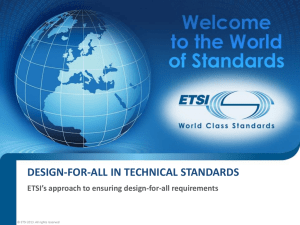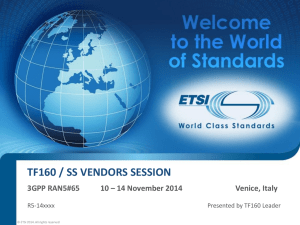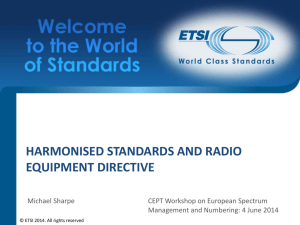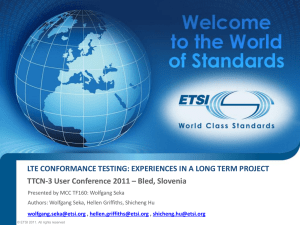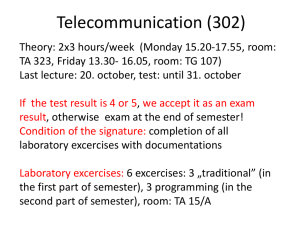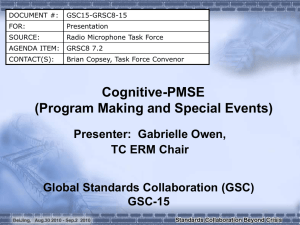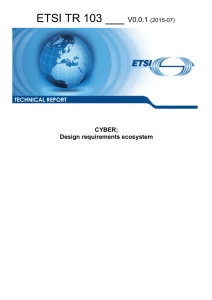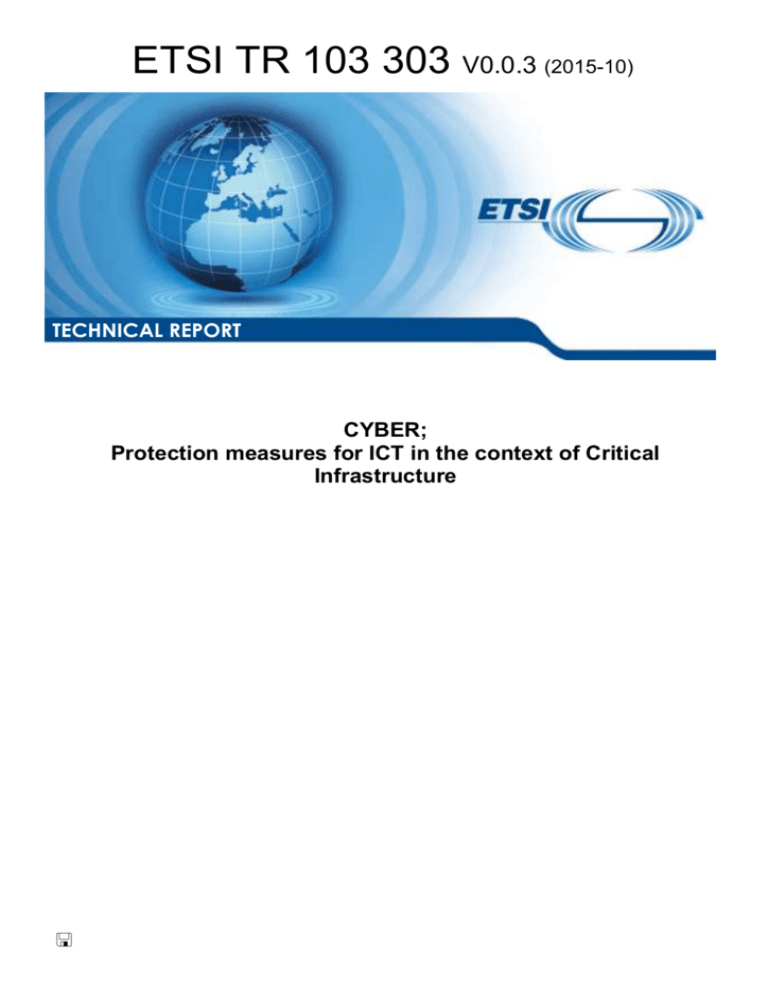
ETSI TR 103 303 V0.0.3 (2015-10)
TECHNICAL REPORT
CYBER;
Protection measures for ICT in the context of Critical
Infrastructure
or [Release #]
2
ETSI TR 103 303 V0.0.3 (2015-10)
Reference
DTR/CYBER-001
Keywords
<keywords>
ETSI
650 Route des Lucioles
F-06921 Sophia Antipolis Cedex - FRANCE
Tel.: +33 4 92 94 42 00 Fax: +33 4 93 65 47 16
Siret N° 348 623 562 00017 - NAF 742 C
Association à but non lucratif enregistrée à la
Sous-préfecture de Grasse (06) N° 7803/88
Important notice
The present document can be downloaded from:
http://www.etsi.org
The present document may be made available in electronic versions and/or in print. The content of any electronic and/or
print versions of the present document shall not be modified without the prior written authorization of ETSI. In case of any
existing or perceived difference in contents between such versions and/or in print, the only prevailing document is the
print of the Portable Document Format (PDF) version kept on a specific network drive within ETSI Secretariat.
Users of the present document should be aware that the document may be subject to revision or change of status.
Information on the current status of this and other ETSI documents is available at
http://portal.etsi.org/tb/status/status.asp
If you find errors in the present document, please send your comment to one of the following services:
http://portal.etsi.org/chaircor/ETSI_support.asp
Copyright Notification
No part may be reproduced or utilized in any form or by any means, electronic or mechanical, including photocopying
and microfilm except as authorized by written permission of ETSI.
The content of the PDF version shall not be modified without the written authorization of ETSI.
The copyright and the foregoing restriction extend to reproduction in all media.
© European Telecommunications Standards Institute yyyy.
All rights reserved.
DECTTM, PLUGTESTSTM, UMTSTM and the ETSI logo are Trade Marks of ETSI registered for the benefit of its Members.
3GPPTM and LTE™ are Trade Marks of ETSI registered for the benefit of its Members and
of the 3GPP Organizational Partners.
GSM® and the GSM logo are Trade Marks registered and owned by the GSM Association.
ETSI
or [Release #]
3
ETSI
ETSI TR 103 303 V0.0.3 (2015-10)
or [Release #]
4
ETSI TR 103 303 V0.0.3 (2015-10)
Contents
Logos on the front page ...................................................................................................................................... 3
Copyrights on page 2.......................................................................................................................................... 3
If an additional copyright is necessary, it shall appear on page 2 after the ETSI copyright. .............................. 3
Intellectual Property Rights ................................................................................................................................ 5
Foreword............................................................................................................................................................. 5
Multi-part documents.......................................................................................................................................................... 5
Modal verbs terminology ................................................................................................................................... 5
Executive summary ............................................................................................................................................ 6
Introduction ........................................................................................................................................................ 6
1
Scope ........................................................................................................................................................ 6
2
References ................................................................................................................................................ 6
2.1
2.2
3
Normative references ......................................................................................................................................... 6
Informative references ....................................................................................................................................... 7
Definitions, symbols and abbreviations ................................................................................................... 7
3.1
3.2
3.3
4
Definitions ......................................................................................................................................................... 7
Symbols ............................................................................................................................................................. 7
Abbreviations ..................................................................................................................................................... 8
User defined clause(s) from here onwards ............................................................................................... 8
4.1
User defined subdivisions of clause(s) from here onwards ................................................................................ 8
Proforma copyright release text block ............................................................................................................... 9
Annexes
........................................................................................................................................................................... 9
Annex <A>:
Title of annex .......................................................................................................................... 9
Annex <B>:
Title of annex .......................................................................................................................... 9
<B.1>First clause of the annex ......................................................................................................................... 10
<B.1.1> First subdivided clause of the annex ................................................................................................................ 10
Annex <C>:
ATS in TTCN-2 .................................................................................................................... 10
<C.1> The TTCN-2 Machine Processable form (TTCN.MP) .......................................................................... 10
Annex <D>:
ATS in TTCN-3 .................................................................................................................... 10
<D.1>TTCN-3 files and other related modules ................................................................................................ 10
<D.2>HTML documentation of TTCN-3 files ................................................................................................. 11
Annex <E>:
Bibliography ......................................................................................................................... 11
Annex <F>:
Change History ..................................................................................................................... 11
History .............................................................................................................................................................. 12
A few examples: ................................................................................................................................................................ 12
ETSI
or [Release #]
5
ETSI TR 103 303 V0.0.3 (2015-10)
Intellectual Property Rights
IPRs essential or potentially essential to the present document may have been declared to ETSI. The
information pertaining to these essential IPRs, if any, is publicly available for ETSI members and
non-members, and can be found in ETSI SR 000 314: "Intellectual Property Rights (IPRs);
Essential, or potentially Essential, IPRs notified to ETSI in respect of ETSI standards", which is
available from the ETSI Secretariat. Latest updates are available on the ETSI Web server
(http://ipr.etsi.org).
Pursuant to the ETSI IPR Policy, no investigation, including IPR searches, has been carried out by
ETSI. No guarantee can be given as to the existence of other IPRs not referenced in
ETSI SR 000 314 (or the updates on the ETSI Web server) which are, or may be, or may become,
essential to the present document.
Foreword
This Technical Report (TR) has been produced by ETSI Technical Committee CYBER.
Modal verbs terminology
In the present document "shall", "shall not", "should", "should not", "may", "may not", "need",
"need not", "will", "will not", "can" and "cannot" are to be interpreted as described in clause 3.2 of
the ETSI Drafting Rules (Verbal forms for the expression of provisions).
"must" and "must not" are NOT allowed in ETSI deliverables except when used in direct citation.
ETSI
or [Release #]
1
6
ETSI TR 103 303 V0.0.3 (2015-10)
Scope
The present document reviews the roles and subsequent requirements for Critical Infrastructure
Protection, in the context of Cyber-Security, in the form of security technologies and security
management, for infrastructures that may be defined, now or in the future, as Critical
Infrastructures.
The present document identifies the role of ICT protections through the deployment of security
technologies and security management to deliver effective Critical Infrastructures that are reliant on
ICT technology. The topics to be addressed by the work item include:
Resilience (taking as input the ENISA reports on this topic and work from related national
programmes);
M2M communications (in close liaison with oneM2M and smartM2M);
eHealth (in order to give assurance of access to ICT enabled eHealth systems).
The report is intended to highlight aspects of CI and ICT that have to be addressed to ensure that CI
maintains its infrastructure role.
2
References
References are either specific (identified by date of publication and/or edition number or version
number) or non-specific. For specific references, only the cited version applies. For non-specific
references, the latest version of the referenced document (including any amendments) applies.
Referenced documents which are not found to be publicly available in the expected location might
be found at http://docbox.etsi.org/Reference.
NOTE: While any hyperlinks included in this clause were valid at the time of publication ETSI
cannot guarantee their long term validity.
2.1
Normative references
The following referenced documents are necessary for the application of the present document.
Not applicable.
ETSI
or [Release #]
2.2
7
ETSI TR 103 303 V0.0.3 (2015-10)
Informative references
The following referenced documents are not necessary for the application of the present document
but they assist the user with regard to a particular subject area.
[i.1]
National Institute of Standards and Technology (NIST): Framework for
Improving Critical Infrastructure Cybersecurity; Version 1.0; February 12, 2014
[i.2]
COUNCIL DIRECTIVE 2008/114/EC of 8 December 2008 on the identification
and designation of European critical infrastructures and the assessment of the
need to improve their protection
[i.3]
COMMISSION OF THE EUROPEAN COMMUNITIES; COM(2006) 786 final;
COMMUNICATION FROM THE COMMISSION on a European Programme for
Critical Infrastructure Protection (Brussels, 12.12.2006)
[i.4]
EUROPEAN COMMISSION; SWD(2013) 318 final; COMMISSION STAFF
WORKING DOCUMENT on a new approach to the European Programme for
Critical Infrastructure Protection Making European Critical Infrastructures more
secure; Brussels, 28.8.2013
[i.4]
Executive Order no. 13636, “Improving Critical Infrastructure Cybersecurity,
DCPD-201300091,” February 12, 2013. http://www.gpo.gov/fdsys/pkg/FR-201302-19/pdf/2013-03915.pdf
[i.5]
Presidential Policy Directive 21 (PPD-21): “Critical Infrastructure Security and
Resilience,” http://fas.org/irp/offdocs/ppd/ppd-21.pdf
[i.7]
Public Safety Canada, “National Strategy for Critical Infrastructure,”
http://www.publicsafety.gc.ca/cnt/rsrcs/pblctns/srtg-crtcl-nfrstrctr/srtg-crtclnfrstrctr-eng.pdf
[i.8]
Public Safety Canada, “Action Plan for Critical Infrastructure (2014-2017),”
http://www.publicsafety.gc.ca/cnt/rsrcs/pblctns/pln-crtcl-nfrstrctr-2014-17/plncrtcl-nfrstrctr-2014-17-eng.pdf
[i.9]
Australian Government,” Critical Infrastructure Resilience Strategy,” 2010,
http://www.tisn.gov.au/Documents/Australian+Government+s+Critical+Infrastruc
ture+Resilience+Strategy.pdf
[i.10]
Japan Information Security Policy Council (ISPC), "Action Plan on Information
Security Measures for Critical Infrastructure, 2005.
[i.11]
NIST et al.: “Cyber-physical systems,” . http://cyberphysicalsystems.org/.
ETSI
or [Release #]
8
ETSI TR 103 303 V0.0.3 (2015-10)
3
Definitions, symbols and abbreviations
3.1
Definitions
For the purposes of the present document, the [following] terms and definitions [given in ... and the
following] apply:
Cyber-physical system: integrations of computation, networking, and physical processes. [i.11]
3.2
Abbreviations
For the purposes of the present document, the [following] abbreviations [given in ... and the
following] apply:
CIA
CIP
EPCIP
NIST
Confidentiality Integrity Availability
Critical Infrastructure Protection
European Programme for Critical Infrastructure Protection
National Institute of Standards and Technology
ETSI
or [Release #]
9
ETSI TR 103 303 V0.0.3 (2015-10)
4
Current status and definitions
4.1
Differing definitions of critical infrastructure
Whilst a simple definition of critical infrastructure is ideal it is clear that there is no commonly
agreed one although many concepts are shared. Table 1 takes some of the common definitions and
whilst it is clear that there is a geographic dimension in each (i.e. the definition addresses a
particular nation state or federation/union of nation states) removal of these aspects allows a
common definition that may be applicable to all nation states.
Table 1: Comparison of definitions
Definition
An asset or system which is essential for the maintenance of vital
societal functions. The damage to a critical infrastructure, its
destruction or disruption by natural disasters, terrorism, criminal
activity or malicious behaviour, may have a significant negative
impact for the security of the EU and the well-being of its citizens.
Systems and assets, whether physical or virtual, so vital to the
United States that the incapacity or destruction of such systems and
assets would have a debilitating impact on security, national
economic security, national public health or safety, or any
combination of those matters.
Processes, systems, facilities, technologies, networks, assets and
services essential to the health, safety, security or economic wellbeing of Canadians and the effective functioning of government.
Critical infrastructure can be stand-alone or interconnected and
interdependent within and across provinces, territories and national
borders. Disruptions of critical infrastructure could result in
catastrophic loss of life and adverse economic effects.
Those physical facilities, supply chains, information technologies
and communication networks which, if destroyed, degraded or
rendered unavailable for an extended period, would significantly
impact on the social or economic wellbeing of the nation or affect
Australia’s ability to conduct national defence and ensure national
security.
Infrastructure which offers the highly irreplaceable service in a
commercial way is necessary for people's normal lives and
economic activities, and if the service is discontinued or the supply
is deficient or not available, it will seriously influence people's lives
and economic activities.
Source
Keywords and concepts
Loss of infrastructure leads to
significant negative impact.
[i.4]
As above but with some restriction to
nationally owned or managed assets
and appears to exclude assets under
private or corporate ownership and
management
As above with concentration on
national security (Canada).
[i.7]
[i.9]
As above with concentration on
national security (Australia).
[i.10]
As above but adding the nongovernmental sector
Common themes across all of the definitions collated in table 1 suggest that a unified definition,
without geographical specialisation (i.e. not explicitly mentioning Australia or Canada or the United
States or the EU), can be proposed.
The guiding principles to derive a common definition include the elements listed below:
Loss or damage to the infrastructure element will lead to (significant) negative impact on
one or more of the following:
-
Economic activity of direct and indirect stakeholders
NOTE: The stakeholders may be direct (e.g.. owner/operators, customers) or indirect (e.g.
citizens impacted by economic downturn which they did not contribute to) and may be a
country/nation-state/region or a business sector but the definition of who is a
stakeholder is not restricted.
-
The safety of the population
ETSI
or [Release #]
-
The security of the population
-
The health of the population
10
ETSI TR 103 303 V0.0.3 (2015-10)
The infrastructure that may be considered as critical is not fixed. As technology and society changes
the influence of technologies on the economy of a nation-state will change. It is reasonable to
suppose that technologies in support of the distribution of clean water and adequate food supplies
will always be considered as part of critical infrastructure thus transport and power, similarly the
technologies to support health care of the populace will be considered as critical. More critically in
some aspects the infrastructures required to maintain the safety and security of the populace need to
be considered as critical. Evolving economic behaviour has moved to the Internet, in extension of
the service market and of the distribution of goods (e.g. many entertainment media are delivered
across the internet). Data centric services have also become a core of economic activity through
initiatives such as openData thus that data infrastructure becomes critical to the maintenance of
economic activity.
4.2
Working definition proposal
Critical infrastructure: Any infrastructure for which loss or damage in whole or in part will lead
to significant negative impact on one or more of the economic activity of the stakeholders, the
safety, security or health of the population.
NOTE: The infrastructure is not limited to physical elements but may include virtual elements
and the associative links between them.
5
Security domains for CI protection
CIs are generally considered to be large in extent supporting very large populations where the
population may refer to number of people, transactions, devices, or in other words where the impact
of loss or damage is significant.
5.1
The cyber-physical system conceptual model
<<TEXT TO BE ADDED TO EXPLAIN THIS DIAGRAM AND WHY IT IS ESSENTIAL IN
THIS DOCUMENT>>
ETSI
or [Release #]
11
ETSI TR 103 303 V0.0.3 (2015-10)
Figure 1: cyber-physical systems concept map. [i.11]
5.2
Review of CIA paradigm and its applicability in CI Protection
5.2.1
Overview
The conventional paradigm for provision of security features is CIA – Confidentiality, Integrity,
Availability. This paradigm is conventionally applied in well defined domains and is often
combined with known tuples of {attack, countermeasure}, such that in the confidentiality branch
the tuple {interception, encryption} will often appear. The characteristics of the common
description of attacks in the CIA paradigm are typically centred on single attack vectors with Alice
and Bob representing the end points of the to-be-secured transaction, and Eve representing the
adversary. The application of CIA to CI is not in question as an attack that causes an outage of some
part of the infrastructure could be as simple as a masquerade attack giving privilege escalation
sufficient to override normal run-time security. Thus CIA should be considered as an essential
building block in protection of CI.
The succeeding subclauses summarise the aims of each of the CIA elements and their role in CI
protection.
ETSI
or [Release #]
5.2.1
12
ETSI TR 103 303 V0.0.3 (2015-10)
Confidentiality
The role of confidentiality protection is to ensure that information shared by Alice and Bob is
intelligible only to Alice and Bob and Eve, even if she can access that information, should be
unable to share the information in like manner to Alice and Bob. In Critical Infrastructure
Protection (CIP) there are many parts of the management of the infrastructure that will be required
to remain confidential and this may include configuration information of assets and their
interactions.
The method of providing confidentiality of data either in storage or in transit for ICT in CI assumes
that access control capabilities have been implemented in the first instance. As in all
cryptographically protected schemes the method of protection (keying) will depend on overall trust
and the
5.2.2.
Integrity
The role of integrity protection is that if Eve modifies data that that modification is detectable by
Alice (and Bob if the data is exchanged with Bob).
NOTE: Bob can, as an actor, be Alice in the future. In other words Alice stores data for future
retrieval, in such a case future-Alice (Bob) should be able to detect if the stored data has
been modified in the period between storage and retrieval.
5.2.2.1
Supply chain integrity
Supply chain integrity is a special case of integrity and addresses the entire chain to the end user. In
this instance the term integrity is closer to the meaning of the term used in written English and
refers to the overall trustworthiness of the supply chain and not to the stability of the supply chain.
In cases such as Just in Time manufacturing attacks on the supply chain may be seen in a number of
ways, for example an attack on the logistics tracking and planning may result in delays in delivery
of components. Whilst such attacks are not necessarily likely to change a “normal” attack to one
where the impact is sufficient to escalate the attack to one impacting critical infrastructure it is
reasonable to consider attacks against supply chain integrity as likely to impact economic activity
and in some cases (e.g. supply of medical relief) to impact the health of a population.
5.2.3
Availability
<<Stuff to go here – access control, authentication and so forth>>
5.3
Resilience
In like manner to CI integrity the problem of CI resilience is that the system is inherently mutable
and in normal operations will be subject to stress that it will be expected to recover from.
6
Measures for CIP
ETSI
or [Release #]
13
6.1
Integrity measures
6.1.1
Identification of stable state
6.1.2
Identification of manipulation of system
6.1.3
Recovery of compromised system
6.2
Availability measures
6.2.1
Access control measures
ETSI
ETSI TR 103 303 V0.0.3 (2015-10)
or [Release #]
14
Annex A:
Title of annex
<Text>.
ETSI
ETSI TR 103 303 V0.0.3 (2015-10)
or [Release #]
15
ETSI TR 103 303 V0.0.3 (2015-10)
Annex E:
Bibliography
NIST: "Cyber-Physical Systems Homepage,” http://www.nist.gov/cps/
NIST: “Foundations for Innovation in Cyber-Physical Systems Wokshop, March 2012,
http://events.energetics.com/NIST-CPSWorkshop/index.html.
National Science Foundation: “Cyber-Physical Systems Virtual Organization,” http://cps-vo.org/.
ETSI
or [Release #]
16
ETSI TR 103 303 V0.0.3 (2015-10)
Annex F:
Change History
Date
Version
Information about changes
ETSI
or [Release #]
17
ETSI TR 103 303 V0.0.3 (2015-10)
History
Document history
0.0.1
December
2014
Outline Table of Contents and adoption of ETSI TR Template
0.0.2
January 2015
Re-structure taking into much of the content of CYBER(15)003012
0.0.3
October 2015
Contribution to CYBER#5
ETSI


